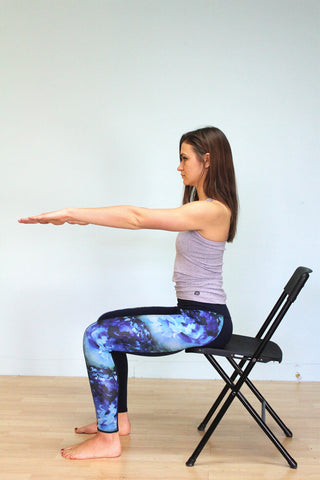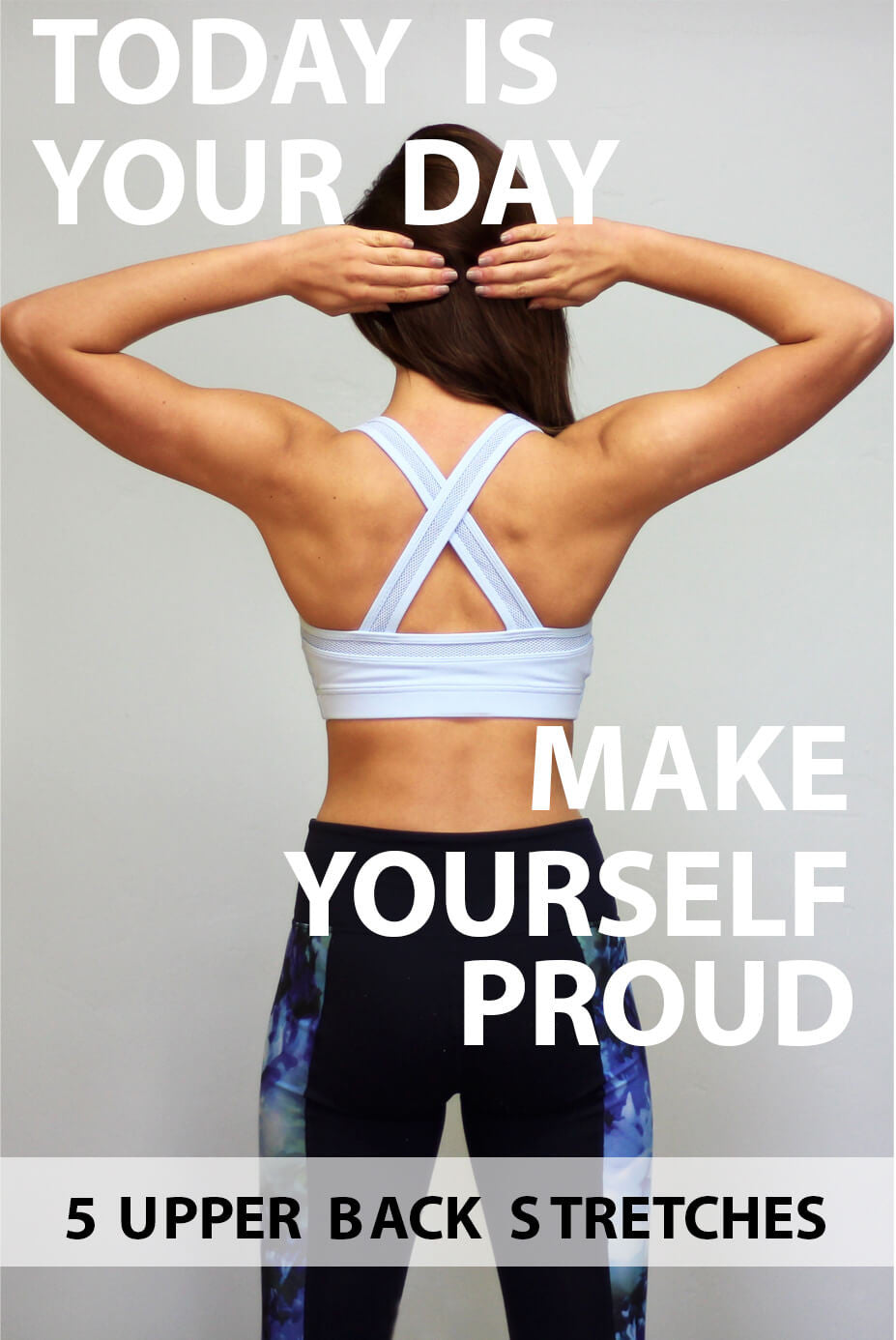Double-tap, like. Scroll. Double-tap, like. Scroll. You have been sitting like this for what seems like only five minutes. Hunched over with your phone in hand, you scroll through your favorite social site reading about your friend from high school who has just completed her fifth marathon. You just heard your name called, so you quickly sit up to respond and then ‘ouch!’ Maybe it wasn’t just five minutes. You look at the time and see that you have been sitting there like the hunchback of Notre Dame for nearly a full hour. You stand up and throw your arms back trying to release the tension. Yep, we all know this routine. It’s your everyday upper back pain that seems to never go away.
5 Stretches to Help Your Back Pain
Here are five simple stretches that you can do right after your intense workout at the gym, your long day in the office, or strenuous social media binge right in your very own living room.
1. Rotating Chair
While sitting on the edge of your chair, place both hands to the back of the head and straighten your posture with shoulders directly over your hips. Keep feet planted as you twist your torso to your left. Hold for at least five seconds. Your body from the waist up should be facing your left as your body from the waist down stays firmly planted in the seated position. Twist back to facing forward and then repeat the process to the right.



2. Chair Arm Raise
Sit on the edge of your chair with shoulders directly over your hips and arms hanging loosely to your side. While feet are firmly planted to the floor, raise your arms slowly above your head keeping elbows locked and shoulders relaxed. Hold arms above your head for 10 seconds taking deep breaths. Slowly release your arms back to your side and repeat five times or until you feel less pain in your upper back.



3. Clasped Hands
While either sitting or standing with shoulders directly over your hips, raise your arms with elbows locked above your head. Clasp your hands. Bend your elbows while lowering your clasped hands behind your head letting them to drop loosely. This should open your chest while tightening your shoulder blades together. Hold bent, clasped hands for 10 seconds. Raise arms above your head and drop back down to your side. Repeat five times.



4. Wheely Good Support
Sit on the floor in a relaxed position with either your legs crossed or knees bent and feet firmly on the ground. Place the Chirp Wheel against your back. While holding onto the wheel, slowly lower your upper back on top of the wheel and allow your head to rest on its mat. Once securely on the wheel, release your hold and lay hands loosely on the ground. Stay in this position for at least 30 seconds while breathing deeply. You can stay longer, or repeat a few times to release your upper back pain.


5. Roll it Out
Sit on the floor with legs bent and feet firmly on the floor. Place the Chirp Wheel about 6 inches from behind your back vertically. Lay your upper back onto the wheel with it in between your shoulder blades while raising your booty off the floor and keeping your knees in a 90-degree angle. Roll back and forth with the wheel on your upper back by bending and straightening your legs. It will be a forward-backward motion. For a deeper stretch lower the back of your head to the mat. Roll out 10 times.


Why does my back hurt?
 Although upper back pain is not as common as lower back pain, once you get it, it seems almost impossible to get rid of. WebMD says its most frequent causes are the overuse of the muscles supporting the spine, poor posture, or possible injury to the ligaments and discs around the spine. Basically, if you do a lot of physical activity that involve your back muscles, or if you spend most of your day huddled around your computer and/or mobile device you may be experiencing it.
Although upper back pain is not as common as lower back pain, once you get it, it seems almost impossible to get rid of. WebMD says its most frequent causes are the overuse of the muscles supporting the spine, poor posture, or possible injury to the ligaments and discs around the spine. Basically, if you do a lot of physical activity that involve your back muscles, or if you spend most of your day huddled around your computer and/or mobile device you may be experiencing it.
To find out what is causing your upper back pain, reflect on your daily routine and when your discomfort starts. If you find that it probably isn’t caused by physical activity you should try Dr. Guevara’s posture test.
It’s called the ‘Mirror Test.’ Stand in front of a mirror with your hands hanging down to your side. If your palms are facing the sides of your body (the outside of your thighs) then you have a stable posture. If your palms are facing what’s behind you, then you will notice that your shoulders are more hunched forward creating tension in between your shoulder blades.
By using the mirror-test, you can see that the pain in your upper back is from an undisciplined posture. Fortunately, there is a way to correct it. Use the 5 stretches listed above every day for a week. Watch your improvement by re-doing the mirror test and you can start to feel as good as new!
How does the Chirp Wheel Help my Upper Back Pain?
 Your spine has four different regions: the cervical, thoracic, lumbar, and sacral. All of these regions follow a natural S-curve. The thoracic spine, which is your upper back, curves inward and helps with mobility while distressing other parts of the spine.
Your spine has four different regions: the cervical, thoracic, lumbar, and sacral. All of these regions follow a natural S-curve. The thoracic spine, which is your upper back, curves inward and helps with mobility while distressing other parts of the spine.
When you have poor posture, you bend your thoracic spine in the opposite direction of its natural curve. As your upper back is being forced to curve more outward from your poor habits, the rest of your body doesn’t receive the amount of support and mobility it needs to handle the physical stresses of the day. The thoracic nerves are connected to many parts of your body and if those nerves are signaling pain, then you may start to feel pain in your hips, lower back, chest, shoulders, knees, etc. Many who have experienced upper back pain have reported that they have an increase of headaches too. Your body is very interconnected and finding the cause of the pain is essential to solving it.
The Chirp Wheel is designed to follow and fit the natural curves of your spine to re-correct what you have mistakenly been doing all day at your desk. The width and diameter of the wheel are specifically made to fit in between your shoulder blades and allow a deep-enough stretch to recreate the curve as you roll-out. A stronger curve means a stronger and more mobile back.
With the Chirp Wheel, you can help re-shape your daily habits and start living without upper back pain. Here is a list of some of the ways the Chirp Wheel can help you.
- Re-correct bad posture
- Rolls out sore and tight muscles around the spine
- Releases myofascial tissue restrictions
- Creates mobility
- Decreases chance of permanent injury
Are you sure it works?
The science behind the Chirp Wheel makes sense, but the most important thing is that it actually works. Jenna Beyer, a very active 22-year-old, had alignment issues and numerous injuries while growing up. She visited chiropractors, acupuncturists, doctors, physical therapists, massage therapists all to find help for her pain. After taking care of her injuries medically she still feels day to day pain, especially doing the activities she loves most.
“It is still important to me to be active and participate in the activities I love, so I have to take care of my body every day,” Beyer said. “So much of that has come from using the wheel to release the tension in my back and neck each morning and night. I have seen a change in my upper back pain and a decrease in my headaches.”

Jenna enjoys hiking and rock climbing with her husband, running, dancing, and practicing yoga. She says that her Chirp Wheel has made a big difference in the way she is able to continue in these activities. As a student studying graphic design, she is sitting in front of the computer for most of the day. She says that simply rolling out the wheel each night has helped keep her back mobile and not stiff the next day. For Beyer, the wheel has been life-changing.
Gift Guide: http://www.rebateszone.com/












